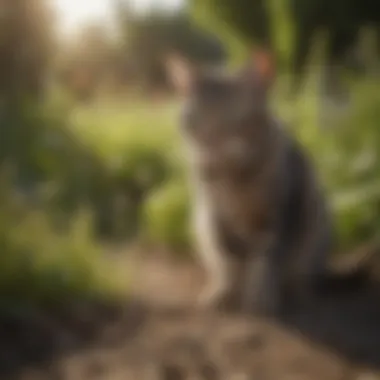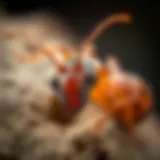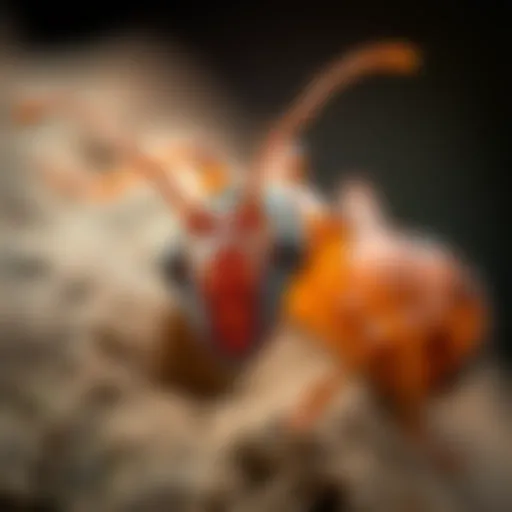Harnessing Catnip: A Natural Approach to Pest Control


Intro
The interest in sustainable living has grown in recent years. Many homeowners seek natural solutions for pest control. One such alternative is catnip. This herb has gained attention due to its effectiveness against various pests. Its use may offer an eco-friendly option compared to traditional chemical pesticides. Catnip contains a compound called nepetalactone, which is known for its insect-repelling properties. This article aims to explore catnip’s role in pest management. It will detail its chemical composition, modes of action, and effectiveness against pests like mosquitoes and cockroaches. By examining practical applications, benefits, and limitations, this guide will help homeowners make informed decisions on pest control.
Pest Identification
Understanding pests is the first step in pest control. Common pests like mosquitoes and cockroaches thrive in homes and gardens. Each poses unique challenges.
Detailed Descriptions of Common Pests
- Mosquitoes are small flying insects known for their bites. They usually breed in stagnant water. Not all mosquitoes are equally bad, but some can transmit diseases.
- Cockroaches are larger insects. They prefer warm, hidden areas such as kitchens and bathrooms. They can contaminate food and surfaces with their droppings.
Signs and Symptoms of Infestations
Identifying infestations sooner rather than later is crucial.
- For mosquitoes, look for bite marks on skin. You may also notice buzzing sounds in the evening.
- Cockroaches leave dark droppings, which resemble black pepper. You might also see their discarded exoskeletons.
"Identifying pests quickly can save time and reduce further damage."
Prevention Strategies
Preventing infestations is often easier than treating them. Simple measures can make a significant difference in keeping your home pest-free.
Home Maintenance Tips for Pest Prevention
- Seal cracks and gaps in windows and doors to prevent entry.
- Maintain cleanliness; regularly clean kitchens to avoid attracting pests.
- Remove standing water; fix leaks and standing water in trays or planters.
Natural Deterrents and Barriers
Incorporating natural barriers can be effective. Catnip serves as one option. Its essential oils can repel mosquitoes. Additionally, planting catnip around areas prone to pests may deter other insects.
Treatment Options
When prevention fails, treatments come into play. Homeowners often weigh the benefits of chemical versus natural treatments.
Overview of Chemical vs. Natural Treatments
- Chemical treatments include sprays and traps. They tend to work quickly but can have harmful effects on health and the environment.
- Natural treatments, such as catnip, may require more time but pose minimal risk to humans and pets.
Step-by-Step Guides for DIY Treatments
For those who prefer a hands-on approach, DIY treatments using catnip are straightforward.
- Dried Catnip Spray: Mix dried catnip with water in a spray bottle. Let it steep overnight. Strain and spray around areas where pests gather.
- Catnip Sachets: Place dried catnip in small cloth bags. Hang them near entry points to deter pests naturally.
This holistic approach to pest control not only helps the environment but can also serve to keep homes pest-free effectively.
Intro to Catnip
Understanding the role of catnip in pest control is crucial for those looking for effective and natural alternatives to chemical pesticides. Catnip, or Nepeta cataria, is widely recognized for its effects on felines, but its potential as a pest deterrent is often overlooked. Homeowners face many challenges in maintaining a pest-free environment, and traditional solutions often carry health and environmental risks. Introducing catnip as an eco-friendly option not only aligns with sustainable practices but also taps into a rich historical usage that many may not be aware of.
Understanding Catnip: Beyond Cat Attraction
Catnip is a herb related to the mint family. Its distinct aroma comes primarily from a compound called nepetalactone. While it induces euphoria in many cats, its effects extend beyond mere attraction to felines. Research indicates that catnip possesses properties that can repel certain pests, making it a viable natural pest control option.
The effectiveness of catnip is useful in various forms, including dried leaves, sprays, and even live plants. Some pests like mosquitoes and cockroaches have shown to be deterred by the scent released by the plant. For homeowners, incorporating catnip into their pest management strategies can offer a safe and non-toxic way to fight infestations.
Historical Use of Catnip in Pest Control
Historically, catnip has been utilized for centuries beyond its use with cats. Ancient civilizations recognized its role in herbal medicine, including pest management. In times past, people used catnip to combat insect nuisances. Records show that in Europe, it was common to plant catnip around homes to ward off pests naturally.
Moreover, it is important to note that traditional knowledge around plants like catnip can provide valuable insights into modern practices. As concern grows over the impact of chemical pesticides on health and the environment, revisiting these historical uses certainly merits consideration. Research continues to validate some of these long-standing beliefs, making catnip's role in integrated pest management an area of interest worth exploring.
Chemical Composition of Catnip
The chemical composition of catnip is a vital aspect of its function as a natural pest control agent. Its unique compounds interact with various insects, ultimately leading to repellent effects that can significantly reduce pest populations in a home environment. Understanding these chemical properties not only illuminates how catnip works but also highlights its potential advantages and limitations in pest management.
Primary Compounds Responsible for Pest Deterrence
The effectiveness of catnip against pests mainly hinges on specific chemical compounds. The primary components include nepetalactone, beta-caryophyllene, and other terpenoids. These elements contribute differently to deterring pests.


- Nepetalactone: Known for its strong aroma, nepetalactone is the most studied compound. Its pungent smell can disrupt insect sensory receptors, leading to behavioral changes in pests.
- Beta-caryophyllene: This compound offers additional repellent properties. It can provide an extra layer of defense, especially against mosquitoes and other biting insects.
These compounds work synergistically, amplifying their effects and making catnip an effective natural choice for homeowners looking for pest control alternatives.
The Role of Nepetalactone
Nepetalactone is a key player in the pest-repelling capabilities of catnip. This compound not only attracts cats but also acts as a natural repellent for various insects. When pests come into contact with nepetalactone, it can affect their behavior and physiology significantly.
For instance, studies have shown that exposure to nepetalactone can inhibit the ability of mosquitoes to sense human odor. This degrades their capacity to locate and bite their hosts.
Additionally, nepetalactone's volatile nature means that it can disperse into the air quickly, allowing it to cover a larger area.
"Consider using catnip strategically in your garden to create a barrier against common pests. Its natural composition offers an organic solution for those seeking to reduce reliance on chemical pesticides."
Modes of Action Against Pests
Understanding the modes of action of catnip against pests is crucial for both homeowners and pest control enthusiasts. This section will detail how catnip interacts with different insects, showcasing its potential as a natural deterrent. Grasping these concepts will facilitate informed decisions on implementing catnip in pest management strategies, to maximize its benefits.
Behavioral Effects on Insects
Catnip has been shown to produce distinct behavioral changes in various insects. For many pests, the presence of catnip can act as a strong repellent. When insects like mosquitoes come into contact with catnip, they often exhibit altered movement patterns. Studies indicate that catnip causes mosquitoes to avoid areas where it is present. The insects demonstrate increased restlessness and decreased feeding behavior when exposed to catnip, significantly reducing their likelihood to breed.
Another notable observation is the way catnip impacts the olfactory recognition of these pests. Insects rely heavily on their sense of smell to locate food and breeding sites. Catnip’s strong aroma can confuse and deter these pests from their intended targets, leading them to seek alternative locations to avoid irritation.
"The behavioral effects of catnip on insects like mosquitoes highlight its potential in reducing pest activity without reliance on synthetic chemicals."
Chemical Repulsion Mechanisms
Aside from behavioral changes, catnip’s chemical properties provide another layer of defense against pests. The primary agent in catnip, nepetalactone, plays a significant role in this mechanism. When insects encounter nepetalactone, it creates a toxic environment for many pests. For instance, evidence shows that cockroaches are sensitive to nepetalactone, leading to a reluctance to inhabit areas treated with catnip.
Nepetalactone affects the nervous systems of insects. Different studies have confirmed that this compound binds to specific receptors in insect systems. This binding can cause a range of responses, from immobilization to neurotoxic effects. Such reactions can make it impractical for pests to stay in areas where catnip is applied, effectively driving them away without the need for harmful chemicals.
Effectiveness Against Common Pests
The topic of effectiveness against common pests is crucial in understanding catnip's potential as a pest control solution. Many homeowners seek alternatives to chemical pesticides due to health and environmental concerns. Catnip, with its intriguing properties, presents a natural option worth exploring.
The focus on specific pests like mosquitoes and cockroaches highlights how catnip's influence can provide practical benefits. These pests are frequent nuisances in households and gardens. If catnip can prove effective against them, it could lead to a safer and more sustainable way to manage these infestations.
Catnip’s Impact on Mosquitoes
Research suggests that catnip significantly affects mosquitoes. The primary compound in catnip, nepetalactone, is known for its repellant properties. Studies indicate that applying catnip oil can repel mosquitoes more effectively than some conventional repellents. This is particularly appealing for homeowners looking for non-toxic solutions during outdoor activities.
When catnip is grown in gardens, it can attract beneficial insects while deterring mosquitoes. This dual benefit can create a more balanced and healthy ecosystem in the yard. The use of catnip for mosquito control taps into the growing demand for organic gardening practices.
"Catnip may serve as a potent natural deterrent against mosquitoes, offering an effective means of maintaining outdoor comfort and safety."
The Efficacy Against Cockroaches
Cockroaches are another common household pest, often resistant to many chemical treatments. Catnip’s ability to deter these pests is noteworthy. The presence of nepetalactone not only affects mosquitoes but also has a strong impact on cockroaches. Studies show that when exposed to catnip extract, cockroaches display aversive behaviors. They tend to avoid areas treated with this natural agent, suggesting its effectiveness as a repellent.
For homeowners, this means that integrating catnip into pest management strategies could offer a simple solution. Placing dried catnip in infested areas or using catnip oil can provide a chemical-free method to reduce cockroach numbers. Not only does this approach help address pest problems, but it also aligns with a more environmentally friendly lifestyle.
Practical Applications for Homeowners
Understanding the practical applications of catnip as a natural pest control agent is crucial for homeowners seeking effective and eco-friendly solutions. Many people gravitate toward chemical pesticides, but catnip offers a viable alternative that integrates well into home gardening and repellent strategies. Homeowners can utilize catnip not only for its pest control properties but also for its ease of cultivation and versatility in various forms.
Growing Catnip for Home Use
Growing catnip is a straightforward endeavor that requires minimal effort and attention. This herb thrives in well-drained soil and prefers sunny locations, making it an ideal candidate for home gardens. To cultivate catnip effectively, follow these steps:
- Choose the Right Location: Select a spot in your garden that receives full sunlight for at least 6 hours a day.
- Soil Preparation: Prepare the soil by ensuring it is loose and has good drainage. Add compost to enhance nutrient content.
- Planting Seeds or Seedlings: You can start catnip from seeds or purchase young plants from a nursery. If using seeds, sow them directly in the garden in spring.
- Watering Routine: Keep the soil mildly moist during the growing season. Overwatering can harm the plant, while underwatering will inhibit growth.
- Harvesting: Cut the stems back when the plant reaches about 12 inches in height. Regular harvesting encourages bushier growth.
By following these practices, homeowners can enjoy a fresh supply of catnip that not only enhances your garden but can also be used for pest control.
Creating Catnip-Based Repellents
Once you have grown a healthy supply of catnip, creating effective repellents is next. Catnip can be transformed into various forms, tailored to meet homeowners’ specific needs and preferences. Here are some methods to consider:
- Catnip Tea Spray:
- Dried Catnip Bags:
- Essential Oil:
- Boil water and steep dried catnip leaves for 10–15 minutes.
- Allow the mixture to cool. Strain the leaves out and pour the liquid into a spray bottle.
- Spray around your home, especially door frames and windows to deter pests.
- Collect dried catnip and place it into small cloth bags or sachets.
- Hang these bags in areas where pests frequent, like the kitchen or pantry. This minor step can ward off small insects looking for food.


- Infuse carrier oil (like almond oil) with catnip by letting it sit in a warm place for several days.
- This oil can be applied to skin as a natural repellent against mosquitoes and other insects.
Using these simple methods, homeowners can create personalized and effective catnip-based repellents. This ensures a pest-free environment without resorting to harsh chemicals that could potentially harm pets or children.
"With catnip as part of your pest control strategy, you embrace a holistic and sustainable approach to managing unwanted pests in your home."
Benefits of Using Catnip for Pest Control
The use of catnip as a natural pest control agent presents significant advantages that align with the contemporary focus on sustainable practices. This section dives into the relevance of catnip in pest management, exploring its merits in an organic context, as well as key environmental considerations.
Organic and Safe Alternative
One of the most compelling arguments for using catnip in pest control is its classification as an organic and safe alternative to synthetic pesticides. Homeowners often express concerns regarding the potential health risks associated with chemical pest control products. Catnip, being a plant-based solution, poses minimal risk to humans and pets. Additionally, it does not contribute to the pollution of waterways or soil, maintaining ecological balance.
Moreover, catnip does not harm beneficial insects, such as bees or ladybugs, which play crucial roles in pollination and pest control themselves. By providing a safer option, catnip allows homeowners to protect their living spaces while preserving the surrounding environment. This makes catnip a suitable choice for families who prioritize safety without sacrificing efficacy.
Environmental Considerations
Another important aspect of using catnip for pest control is its minimal environmental impact. Unlike conventional pesticides, catnip does not accumulate in the ecosystem, avoiding the long-term detrimental effects associated with chemical residues. This trait makes catnip a more responsible choice for those concerned about the ecological footprint of their pest management strategies.
Furthermore, cultivating catnip only requires basic gardening knowledge. It can flourish in various conditions, needing little more than sunlight and water. Its growth contributes positively to air quality, as plants naturally absorb carbon dioxide and release oxygen.
"Using catnip supports organic gardening while protecting the health of your family and the planet."
In summary, catnip stands out as a viable and eco-friendly pest control solution. It offers safety for humans and pets while ensuring the protection of beneficial ecological systems. This dual benefit positions catnip effectively within the broader context of sustainable pest management.
Limitations of Catnip as a Pest Control Solution
While catnip presents a promising natural solution for pest control, it is essential to acknowledge its limitations. Understanding these limitations is critical for homeowners who may rely on catnip as a primary pest deterrent. Here, we explore two significant aspects: the short-lived efficacy of catnip and the species-specific responses it elicits from various pests.
Short-Lived Efficacy
One major limitation of catnip is its short-lived efficacy. The compounds in catnip, primarily nepatalactone, can lose their potency over time, especially when exposed to environmental factors. These include sunlight, moisture, and air, which can degrade the repellent properties of catnip rapidly. Homeowners might find that the effectiveness diminishes not long after application.
In practical settings, this means that repeated applications are often necessary to maintain pest control benefits. Depending on the specific conditions of the area being treated, individuals may need to refresh catnip-based solutions quite frequently. Users might also find that crushed leaves or catnip sprays require reapplication after rain or cleaning processes.
Species-Specific Responses
Another limitation is the species-specific responses exhibited by insects. Not all pests react to catnip in the same way. Some species may be significantly deterred, while others exhibit little to no response. For instance, while catnip has shown effectiveness against common pests like mosquitoes and cockroaches, it may not deter pests such as ants or termites effectively.
This variability is crucial for homeowners to consider when deploying catnip as a pest control agent. Relying exclusively on catnip may lead to false security, particularly if certain pest species are resistant to its effects. Homeowners should educate themselves about the specific pests they are dealing with to determine the best mix of pest control solutions, ensuring that they are prepared for those that may ignore the natural repellent.
"Understanding the limitations of catnip is crucial for effectively managing pest populations. Relying only on catnip without considering other methods might lead to disappointment in pest management efforts."
By addressing these limitations, homeowners can take a balanced approach to pest control, complementing catnip with other strategies when necessary. This enhances the overall effectiveness of their pest management plans.
Comparative Analysis with Other Pest Control Methods
A thorough comparison of catnip with other pest control methods is vital for homeowners seeking effective solutions. Understanding how catnip stacks up against traditional chemicals and other natural alternatives helps in making informed choices. This section will highlight specific advantages of using catnip, potential drawbacks, and the broader context of its application in integrated pest management strategies.
Catnip vs. Chemical Pesticides
Chemical pesticides have been the go-to choice for pest control for many years. These products often show immediate results against a variety of pests, but they come with significant drawbacks. Chemical pesticides can pose health risks to humans and pets. They may also lead to environmental harm, affecting beneficial insects and pollinators.
On the other hand, catnip offers a much safer option. The primary compound, nepetalactone, acts as a natural insect repellent without the toxicity associated with many chemicals. Extensive use of chemical pesticides can lead to resistance in pests, diminishing their effectiveness over time. In contrast, catnip can often induce behavioral changes in pests, deterring them without causing harm to the ecosystem.
"Natural alternatives like catnip provide homeowners not only safety but also sustainable pest management solutions."
- Catnip does not harm beneficial insects.
- It materializes from organic sources, contributing to a healthier environment.
- Cost-effective for long-term pest management as catnip can be grown at home.
In summary, while chemical pesticides may deliver immediate results, catnip provides a safer, sustainable, and potentially more effective long-term pest control method for conscientious homeowners.
Integrating Catnip with Other Natural Solutions
Combining catnip with other natural solutions enhances its efficacy as a pest control agent. For example, using catnip alongside essential oils such as peppermint or eucalyptus can amplify repellent properties, creating a more formidable barrier against pests.
- Peppermint Oil: Known for its strong scent; it can work synergistically with catnip.
- Garlic: Another natural deterrent that can complement catnip reducing pest attraction.
- Neem Oil: Effective against a range of insects and can bolster the effectiveness of catnip.
Homeowners can create sprays by mixing catnip extracts with these essential oils. Such mixtures can target a broader range of pests while reducing the risk of resistance that often accompanies single-method pest control strategies.
Research suggests that combining methods can create a more holistic approach, fostering a pest management strategy that is more resilient and adaptive.
Common Myths and Misconceptions


Understanding the myths surrounding catnip's pest control abilities is crucial for homeowners considering this natural alternative. Some misconceptions can impede effective pest management strategies. A clear view of what catnip can and cannot do will help inform better decisions when combating pests. This section addresses two prominent myths that often circulate within communities.
Myth: Catnip Works for All Pests
One prevalent myth is that catnip is universally effective against all pests. This belief may have arisen from catnip's strong reputation among pet owners for its attracting properties for felines. However, the truth is more nuanced. While certain studies show that catnip can repel specific insects, its effectiveness varies widely among different species.
For example, research suggests that catnip is particularly effective against mosquitoes and cockroaches, but its efficacy against other pests can be limited.
- Mosquitoes: Catnip contains nepetalactone, which has been shown to disrupt mosquito behavior.
- Cockroaches: Similarly, cockroaches demonstrate a marked aversion to catnip, making it an effective deterrent.
Still, there is little evidence to suggest that catnip will repel ants, flies, or other common pests. Homeowners should focus on integrating catnip into a broader pest control strategy that includes other methods, particularly for insects where catnip is less effective.
Myth: Catnip is Just for Cats
Another myth that deserves attention is that catnip is solely a cat-related phenomenon. Many people associate catnip solely with feline entertainment, overlooking its potential in pest management. While it is true that cats are attracted to catnip and often react in playful ways, this plant holds properties beneficial for pest control.
Households with no cats may dismiss catnip as irrelevant; however, its usefulness extends beyond mere feline engagement.
- Pest Control Agent: It serves as a natural repellent against select pests. This property is increasingly recognized by those seeking eco-friendly solutions.
- Gardening Benefits: Additionally, growing catnip can enhance the overall health of a garden by attracting beneficial insects.
By understanding these myths, homeowners can more accurately gauge the role of catnip in their pest management efforts. Instead of relying on misconceptions, individuals should embrace the nuanced science behind catnip's effectiveness and adjust their pest control strategies accordingly.
Scientific Research and Findings
Understanding the scientific research behind catnip as a pest control agent is vital. It offers insight into its effectiveness and practical applications for homeowners. Through rigorous studies, we can better appreciate how catnip operates against various pests. Such studies reveal both the strengths and limitations of using catnip, guiding homeowners in informed decisions for pest management. Effective research provides data-driven conclusions that can influence how catnip is perceived in the context of natural solutions.
Recent Studies on Catnip and Pest Control
Several studies have delved into the pest-repelling properties of catnip. For example, researchers have identified the specific compounds responsible for deterring insects. Nepetalactone is the most discussed compound. Studies show that it can repel mosquitoes and cockroaches effectively, making it a topic of interest in pest management
Some findings indicate:
- Mosquitoes showed decreased landing rates on treated surfaces with catnip extract.
- Cockroaches exhibited avoidance behavior when exposed to high concentrations of catnip.
These studies underline the potential of catnip as an eco-friendly alternative to chemical pesticides. They also suggest varying effectiveness depending on pest species, making tailored applications important.
Implications of Findings for Homeowners
The implications of these findings are significant for homeowners. They suggest that implementing catnip could provide an organic solution to common pest problems. By using catnip, individuals may reduce their reliance on chemical treatments, leading to safer environments for families and pets.
Several actionable insights emerge:
- Homeowners can grow catnip in their gardens for personal use.
- Creating homemade repellents using catnip provides a direct method for pest control.
- Understanding the limitations highlighted in studies allows for better expectations. For instance, while catnip may be effective against certain pests, it may not work for all species.
In summary, scientific research establishes a foundation upon which homeowners can build practical pest management strategies. By aligning these insights with personal needs, catnip emerges as a viable natural alternative.
Finales and Recommendations
The conclusions and recommendations of this article indicate the growing potential of catnip as a natural pest control agent. Understanding the role of catnip in pest management can help homeowners make informed decisions about pest control solutions. The evidence presented shows that catnip offers an organic alternative to traditional chemical pesticides. This is essential given the rising concerns regarding health and environmental impacts associated with synthetic substances.
Effective Use of Catnip in Pest Management
To effectively utilize catnip in pest management, homeowners should consider a few key strategies. Firstly, growing catnip can easily provide a sustainable source of pest control at home. Catnip can be planted in gardens or in pots for easy access. Its growth is straightforward and does not require elaborate care. Once mature, catnip leaves can be used to create simple repellents.
- Creating Catnip Spray: One effective method is to steep dried catnip leaves in boiling water, allow it to cool, and then strain the liquid. This spray can be used on surfaces where pests are common, such as window sills or door frames.
- Using Fresh Leaves: Crushing fresh leaves and placing them in areas frequently visited by pests can also deter insects. The volatile oils released from the leaves act as a natural repellent.
- Combining with Other Herbs: Integrating catnip with other natural repellents, such as peppermint or rosemary, can enhance its effectiveness. This combination can create a more robust barrier against various pests.
These methods are not only practical but help in reducing reliance on harmful chemicals that could affect household health.
Future Research Directions
The future of catnip as a pest control agent remains promising, yet more research is needed. Ongoing studies should focus on the long-term effects of catnip on different pest populations. A deeper understanding of how catnip interacts with other natural pest repellents can provide insights for integrated pest management strategies.
Additionally, researchers should explore the potential commercialization of catnip-based products. This could further support homeowners in accessing natural pest control solutions.
There is also a need for research to refine the methods of extraction and concentration of catnip’s active compounds. Increased potency may offer more effective control against pests.
Importance of References in This Article
- Validation of Claims: References provide the necessary support for the statements made throughout this discussion. This includes data about catnip's effectiveness against specific pests, its chemical properties, and practical usage in homes.
- Historical Context: By referencing historical studies and applications of catnip, readers can understand how its use has evolved and gained popularity as a natural pest control method. This background adds depth to the narrative, making the case for catnip stronger.
- Guiding Further Research: References can lead interested readers toward additional research materials. They can explore topics such as botanical pest control and organic gardening practices, enriching their knowledge and understanding.
Specific Elements to Consider About References
- Peer-Reviewed Journals: Articles from peer-reviewed journals provide reliable data. These references are essential for validating the methods used in studies about catnip and pest control. Examples include the Journal of Pest Science and Pest Management Science.
- Historical Texts: Documents from agricultural history explain how various cultures have used catnip for pest management. Understanding this history can provide context for modern applications.
- Studies on Chemical Components: Recent studies focusing on nepatalactone and other compounds in catnip can further support claims made in this article. Academic papers detailing those findings can serve as robust references.
- Consumer Insights: Websites that aggregate user experiences, such as Reddit and Facebook, can provide anecdotal evidence supporting catnip’s efficacy in home settings. These platforms often show how others have successfully implemented catnip-based solutions in their pest control strategies.
"Pest control methodologies are only as good as the evidence supporting them. Relying on verifiable references enhances the overall discussion and trust in the recommended practices."
Concluding Remarks on References
In summary, references are much more than just a list of sources. They enhance the credibility and richness of the information shared in this article. For homeowners, understanding the efficacy of catnip as a pest control agent becomes clearer when backed by solid research and historical context. Always seek knowledge from reliable sources to make informed decisions regarding pest management strategies.



